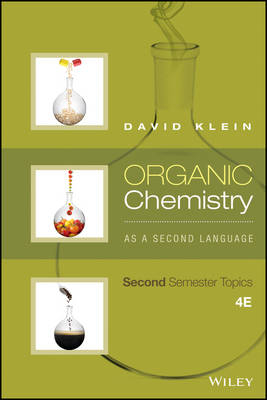
Organic Chemistry As a Second Language: Second Semester Topics
John Wiley & Sons Inc (Verlag)
978-1-119-11065-1 (ISBN)
- Titel erscheint in neuer Auflage
- Artikel merken
David Klein is a Senior Lecturer in the Department of Chemistry at Johns Hopkins University where he has taught organic chemistry since 1999. Having worked with thousands of students, he has intense first-hand knowledge of how they learn and the difficulties they encounter. He received his bachelor's degree in chemistry from Johns Hopkins University and his PhD from the University of California at Los Angeles under the supervision of Professor Orville Chapman. Motivated by his experiences teaching organic chemistry as a graduate student at UCLA, David wrote Organic Chemistry as a Second Language(John Wiley & Sons, 2004, updated 2nd edition published in 2008), which has become a highly valued student study resource. David has received numerous teaching awards at both UCLA and Johns Hopkins for his unique, skill-building approach to organic chemistry instruction. David is married with five children, and he enjoys skiing, scuba diving, and Tae Kwon Do.
Chapter 1 Aromaticity 1
1.1 Introduction to Aromatic Compounds 1
1.2 Nomenclature of Aromatic Compounds 2
1.3 Criteria for Aromaticity 6
1.4 Lone Pairs 10
Chapter 2 IR Spectroscopy 13
2.1 Vibrational Excitation 14
2.2 IR Spectra 15
2.3 Wavenumber 16
2.4 Signal Intensity 21
2.5 Signal Shape 23
2.6 Analyzing an IR Spectrum 31
Chapter 3 NMR Spectroscopy 38
3.1 Chemical Equivalence 38
3.2 Chemical Shift (Benchmark Values) 42
3.3 Integration 47
3.4 Multiplicity 51
3.5 Pattern Recognition 54
3.6 Complex Splitting 55
3.7 No Splitting 57
3.8 Hydrogen Deficiency Index (Degrees of Unsaturation) 58
3.9 Analyzing a Proton NMR Spectrum 61
3.10 13C NMR Spectroscopy 66
Chapter 4 Electrophilic Aromatic Substitution 69
4.1 Halogenation and the Role of Lewis Acids 70
4.2 Nitration 74
4.3 Friedel-Crafts Alkylation and Acylation 77
4.4 Sulfonation 84
4.5 Activation and Deactivation 89
4.6 Directing Effects 91
4.7 Identifying Activators and Deactivators 101
4.8 Predicting and Exploiting Steric Effects 111
4.9 Synthesis Strategies 119
Chapter 5 Nucleophilic Aromatic Substitution 125
5.1 Criteria for Nucleophilic Aromatic Substitution 125
5.2 SNAr Mechanism 128
5.3 Elimination-Addition 134
5.4 Mechanism Strategies 139
Chapter 6 Ketones and Aldehydes 142
6.1 Preparation of Ketones and Aldehydes 142
6.2 Stability and Reactivity of C=O Bonds 146
6.3 H-Nucleophiles 148
6.4 O-Nucleophiles 153
6.5 S-Nucleophiles 166
6.6 N-Nucleophiles 168
6.7 C-Nucleophiles 178
6.3 H-Nucleophiles 148 6.4 O-Nucleophiles 153 6.5 S-Nucleophiles 166 6.6 N-Nucleophiles 168 6.7 C-Nucleophiles 178 6.8 Some Important Exceptions to the Rule 188
6.9 How to Approach Synthesis Problems 192
Chapter 7 Carboxylic Acid Derivatives 200
7.1 Reactivity of Carboxylic Acid Derivatives 200
7.2 General Rules 201
7.3 Acid Halides 205
7.4 Acid Anhydrides 214
7.5 Esters 216
7.6 Amides and Nitriles 226
7.7 Synthesis Problems 235
Chapter 8 Enols and Enolates 244
8.1 Alpha Protons 244
8.2 Keto-Enol Tautomerism 246
8.3 Reactions Involving Enols 251
8.4 Making Enolates 254
8.5 Haloform Reaction 257
8.6 Alkylation of Enolates 260
8.7 Aldol Reactions 265
8.8 Claisen Condensation 272
8.9 Decarboxylation 279
8.10 Michael Reactions 286
Chapter 9 Amines 295
9.1 Nucleophilicity and Basicity of Amines 295
9.2 Preparation of Amines Through SN2 Reactions 297
9.3 Preparation of Amines Through Reductive Amination 301
9.4 Acylation of Amines 305
9.5 Reactions of Amines with Nitrous Acid 309
9.6 Aromatic Diazonium Salts 312
Chapter 10 Diels-Alder Reactions 315
10.1 Introduction and Mechanism 315
10.2 The Dienophile 318
10.3 The Diene 320
10.4 Other Pericyclic Reactions 326
Answers 329
Index 375
| Erscheint lt. Verlag | 19.4.2016 |
|---|---|
| Verlagsort | New York |
| Sprache | englisch |
| Maße | 155 x 231 mm |
| Gewicht | 499 g |
| Themenwelt | Naturwissenschaften ► Chemie ► Organische Chemie |
| ISBN-10 | 1-119-11065-3 / 1119110653 |
| ISBN-13 | 978-1-119-11065-1 / 9781119110651 |
| Zustand | Neuware |
| Informationen gemäß Produktsicherheitsverordnung (GPSR) | |
| Haben Sie eine Frage zum Produkt? |
aus dem Bereich



